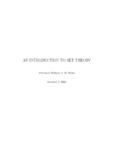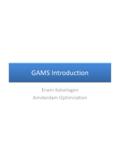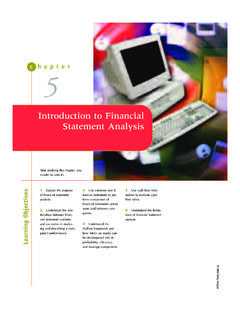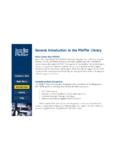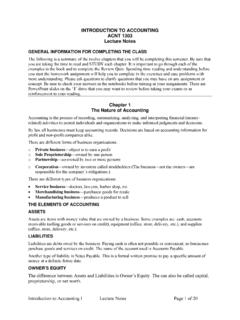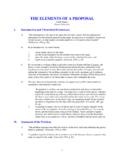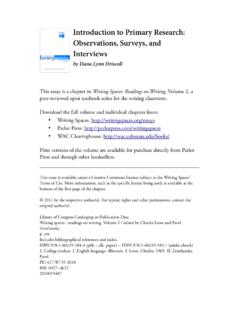Transcription of Introduction to FORTRAN 90
1 Copyright Janet A Nicholson 2011 1 Introduction to Programming using FORTRAN 95 These worksheets aim to provide an Introduction to programming. The language chosen for this is FORTRAN 95. This is because FORTRAN is particularly suitable for science and engineering; it is also very widely available. The skills you acquire working through these notes can be applied to any computing language. The concepts you will learn are shared in common with every other computing language. This document and all the examples may be found online at: Janet A Nicholson 2011 Copyright Janet A Nicholson 2011 2 1 THE BASICS .. 3 AIMS .. 3 INSTALL FTN95 PERSONAL EDITION .. 3 YOUR FIRST PROGRAMMING SESSION .. 3 PLATO A PROGRAMMING ENVIRONMENT .. 3 RUNNING YOUR FIRST FORTRAN 95 PROGRAM.
2 4 PROGRAM STRUCTURE .. 6 MORE ON INPUT AND OUTPUT .. 6 MORE DATA TYPES INTEGER AND CHARACTER .. 8 SAVING THE CONTENTS OF OUTPUT WINDOW .. 10 2 MAKING DECISIONS .. 11 AIMS .. 11 ASSIGNMENT .. 11 ARITHMETIC .. 11 INTRINSIC FUNCTIONS .. 12 MAKING DECISIONS .. 13 PROGRAM STYLE .. 14 MORE ON DECISION MAKING .. 14 OTHER LOGICAL OPERATORS .. 14 MULTIPLE CONDITIONS .. 15 THE SIMPLE IF STATEMENT .. 15 IMPORTANT NOTE TESTING FOR ZERO .. 16 3 LOOPS .. 17 AIMS .. 17 MIXING VARIABLE TYPES .. 17 THE DO LOOP .. 18 NESTED DO LOOPS .. 19 USING LOOPS TO DO SUMMATION .. 20 4 USING FILES AND EXTENDING PRECISION .. 22 AIMS .. 22 READING FROM FILES .. 22 WRITING TO FILES .. 23 EXTENDING THE 23 MAGNITUDE LIMITATIONS .. 25 CONVERGENCE EXITING LOOPS ON A CONDITION.
3 25 5 ARRAYS AND FORMATTED I/O .. 27 AIMS .. 27 ARRAYS .. 27 ARRAY MAGIC .. 29 MULTI DIMENSIONAL ARRAYS .. 30 FORMATTING YOUR OUTPUT .. 31 Integer Specification .. 32 Floating point Specification .. 32 Exponential Specification .. 32 Character Specification .. 33 IMPLIED DO LOOP TO WRITE ARRAYS .. 33 6 SUBROUTINES AND FUNCTIONS .. 35 AIMS .. 35 RE USING CODE THE SUBROUTINE .. 35 ARGUMENTS TO SUBROUTINES .. 36 USER DEFINED FUNCTIONS .. 38 7 ADVANCED TOPICS .. 40 AIMS .. 40 ARRAY FUNCTIONS .. 40 WRITING REAL PROGRAMS FLOW CHARTS .. 42 Copyright Janet A Nicholson 2011 3 1 The Basics Aims By the end of this worksheet, you will be able to: Create and run a FORTRAN 95 program Understand basic program structure Start to deal with programming errors Start to understand real, integer and character variable types.
4 Save a copy of your output in Word. Install FTN95 Personal Edition Search for Silverfrost FTN5 personal edition or click this link Download and install the software accepting all the defaults. Your first programming session Locate and double click the Plato icon Click File, New Select Free Format FORTRAN File Click File, Save As Create a directory called fortranprograms and open it Type Plato a programming environment Copyright Janet A Nicholson 2011 4 Plato is a "programming environment". Within Plato, you can create and edit programs and get them to run. Plato's editor is special it understands the syntax of various programming languages. We tell Plato which language we are using when we create our empty file and save it with a.
5 F95 ( FORTRAN 95) extension. Provided you have given your file the appropriate extension, Plato's editor will be able to check the syntax of the program, highlighting the various keywords that it knows about using a colour code to distinguish between the various elements of the language. Always ensure that your program files have a .f95 extension Running your first FORTRAN 95 Program Exercise Type in the following exactly as shown: !My first program program first print *,'This is my first program' end program first Copyright Janet A Nicholson 2011 5 Click the black , (the Execute button). Plato will get FTN95 to check your program for errors. If it finds any problems, it will give you the details. If you have typed in the program exactly as shown above, an executable file will be generated ( ).
6 Plato will then automatically get the program to start executing. A banner will appear for a couple of seconds and will then disappear (that"s the price we have to pay for using the free software) A black console window will appear. Press Return to close the window. Do not click the X at the top right of the window. Plato can get upset if you do not press Return to close the window, try Save your program first! Run the program again (click ) This time click the X at the top right of the window to close it. Make up your own mind about which is the better way to close this window in future! Copyright Janet A Nicholson 2011 6 Program Structure Examine the following short program: program sum !a: name of program !an example of program structure !
7 B: a comment real :: answer,x,y !c: declarations print *, 'Enter two numbers' !d: output read *, x !e: input read *, y !e: input answer=x+y !f :arithmetic print *, 'The total is ', answer !g: output end program sum !h: end of program There are a number of general points here: The program is made up of a number of lines. Each line is called a statement. Each statement is made up of variable names answer, x, y operators +,- etc keywords read, print The statements are executed sequentially. Let's break the program down, line by line: a) The name of the program. Keep it reasonably short and meaningful. b) A comment explaining the purpose of the program. Comments are indicated by an exclamation mark. All text to the right of an exclamation mark is ignored by the compiler.
8 Programmers use comments to help them remember how a program works. Use of appropriate comments in programs aids understanding and is good practice. c) Variables answer, x and y are used to store floating point numbers we indicate this by declaring them as real. d) print *, outputs to the screen the asterisk means use the default number of decimal places when the number is written to the screen. e) We read information from the keyboard and store the values in x and y. f) Do some arithmetic and store the answer in answer. g) Output the result to the screen h) Conclude the program More on Input and Output Exercise Open a new file and call it Type in the following program: program io real :: x,y,z print *, 'enter the values x,y and z' read *, x,y,z print *, 'the values you typed are for z,y,x are: ',z,y,x end program io Execute it by pressing You can enter the numbers one at a time and press the Enter key each time.
9 Execute the program again This time type all three numbers on one line separated by commas. Copyright Janet A Nicholson 2011 7 Look at the print statement print *, 'the values you typed are for z,y,x are: ',z,y,x In this statement, we are outputting four separate things, a literal string of characters, 'the values you typed are for z,y,x are: ' and the variables z, y, and x. We may output several items at one time, provided they are separated by commas. Exercise The following program has a number of errors. Create a new file called and then type in the following program exactly as shown. You can also download this file from example program bug this program is full of errors real :: a,b,c a = b + c read *,c print *,a end program simple The compiler will report two error messages when it attempts to compile.
10 Click on the details button. Each error generates a message. Double clicking on the message will take you to the line in the program where the fault occurs. Copyright Janet A Nicholson 2011 8 Correct the two errors. Click Execute There is now one further error, Plato will provide a yellow warning alert. Watch the screen carefully! The window will close and then the program will start to execute. Something is not correct the program will "hang". It is actually waiting for you to input a value, because of the line read *,c. To the user of the program, this is not at all obvious they may have thought that the program has crashed! Type in a number then press enter The program returns an strange value. This is an "execution time" error. We need to find out what the warning message was.

